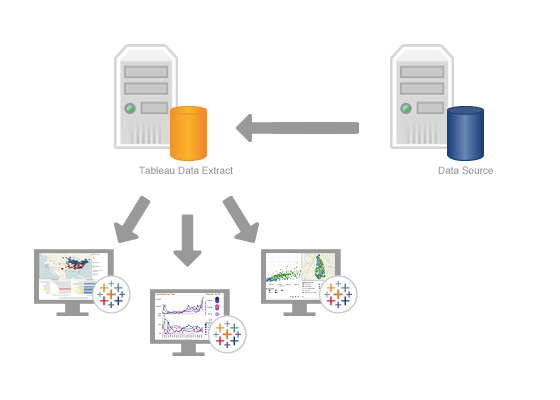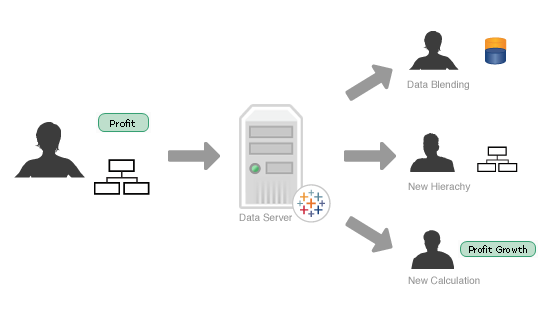Sneak Peek: Tableau Data Server
The upcoming version of Tableau Server 7.0 will include an exciting new capability to centralize data connections yet provide users with flexibility to ask any question about the data.
The Data Server is a component of Tableau Server that will provide centralized management of Tableau Data Extracts and database connections. Tableau Data Extracts and Database connections can be managed centrally within Tableau Server and shared across workbooks. This provides a number of key benefits including:
• Shared data extracts across workbooks
• Schedules based on individual data extracts rather than for each workbook
• Extracts stored on the server rather than downloaded/uploaded for each workbook
• Reduced memory usage by loading the extract once to memory rather than for each workbook
Tableau Desktop users can connect to these centralized Data Extracts in the same way that they connect to any other data source. Queries are executed on the server rather than on the desktop. Users can enrich the data model locally providing centralized management of the data and user flexibility.

Tableau Server can also be used as a database connection proxy by centrally installing and configuring database drivers. Tableau Desktop users then connect through Tableau Server to access the back-end database server reducing the need to deploy, configure, and update database drivers on each client. Additionally, Tableau Server permissions define who can access the various connections to provide an easy way to manage access to your databases.
There are several benefits of the Tableau Data Server but I would like to highlight three areas that will help drive more value out of your data.
Centralized Extracts and Data Sources
You can now publish Tableau Data Extracts to Tableau Server to share with colleagues. The published data extract includes all hierarchies, calculations, user filters, sets and groups created in Tableau Desktop. You can now create multiple workbooks based on the same centralized data extract. The data is not duplicated for each workbook. Each user connects to the same data stored on the server. Data model definitions are also shared across users. For example, if you define a calculation for profit in a data source than each user that connects to this data source will get the exact same definition of profit.
Another way to look at this is that the Data Server provides a centralized metadata model and data storage for your organization. Changes to the master data source can be automatically propagated to workbooks that use the data source. At any stage of creating a data source, the metadata can be published to the Tableau Server. This will help ensure consistency across the organization so everyone is looking at the same definitions of key business data.

Managed & Secure
With the addition of the Data Server, it is easy to schedule extract refreshes and manage them in Tableau Server. You can centrally define a schedule for your extracts on the server for both incremental and full refreshes. This ensures that all of your workbooks are working on consistent data.
With the Data Server, your connections always respect the security settings you set, whether it is through Tableau or at the database level. Published data sources can be secured to control which users can view, connect, delete, and download this data source.
Tableau Server also provides a centralized location to manage all of your published data sources. You can delete, change permissions, add tags, and manage schedules in one convenient location.
End-User Empowerment
The Data Server provides organizations with a centralized data source and metadata layer – yet still enables users to modify and extend it to meet their specific business needs. Users can add their own calculations; create new groups, sets and parameters; organize data into hierarchies; modify aliases; etc.
When the underlying data source changes, Tableau will adapt to a number of changes so that users can continue to consume analysis without disruption

We are very excited about the new capabilities provided by the Data Server in Tableau 7.0. This will help you do more with your data; sharing it more easily across the organization; and empower users to ask more questions of the data.
Abonnez-vous à notre blog
Obtenez les dernières nouvelles de Tableau dans votre boîte de réception.



